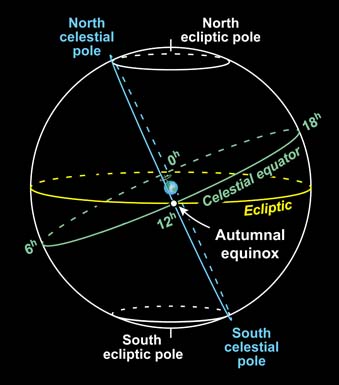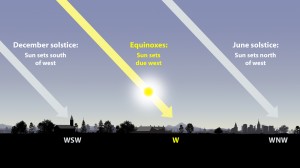What is the "fall equinox" — and how do we know when it happens?
To those who’ve unpacked their winter coats, closed their windows at night, and felt that telltale crispness in the air, it seems that autumn has already started. Astronomically speaking, however, the fall season only comes to the Northern Hemisphere on Tuesday, September 23rd at 2:29 Universal Time (10:29 p.m. EDT on Monday, the 22nd). At that moment, the Sun shines directly on Earth’s equator, heading south as seen in the sky. For us northerners, this event is called the autumnal equinox.
This seems awfully precise for seasons that gradually flow from one to the next, but the reason astronomers regard this event as the “End of Summer” and “Beginning of Fall” is because it is marked by a key moment in Earth’s annual orbit.

S&T / Gregg Dinderman
The apparent position of the Sun in our sky is farther north or farther south depending on the time of year due to the globe's axial tilt. Earth's rotational axis does not point straight up and down, like the handle of a perfectly spinning top, but is slanted about 23½° with respect to our orbit around the Sun.
Another way to think of this is that the plane defined by Earth's orbit around the Sun (called the ecliptic) is tilted with respect to the planet's equator. From our perspective, the Sun follows the ecliptic in its path through the sky throughout the year. Each day the Sun's daily arc moves northward or southward, depending on the time of the year. To observers at northern latitudes (in the U.S., Canada, and Europe, for example), the Sun appears to sneak higher in the sky from late December to late June, only to drop down again from late June through late December. The equinox occurs when the Sun is halfway through each journey.
This axial tilt also produces our seasons. When Earth is on one side of its orbit, the Northern Hemisphere is tipped toward the Sun and receives more direct solar rays (and more daylight hours) that produce the familiar climes of summer. Six months later, when Earth is on the opposite side of its orbit, the Northern Hemisphere is tipped away from the Sun. The slanting solar rays heat the ground less and daylight is shorter, producing the colder winter season.

Sky & Telescope illustration
The same pattern occurs, but in reverse, for the Southern Hemisphere. There September’s equinox marks the beginning of spring, while March’s equinox signals the start of fall. Christmas is a warm holiday in Sydney, Australia. For those living in equatorial regions, however, there are usually only two recognizable seasons: wet and dry; and the days themselves vary less in length.
Several other noteworthy situations happen on the equinoxes:
- Day and night are nearly the same length; the word “equinox” comes from the Latin aequinoctium, meaning “equal night,” according to the Oxford English Dictionary. However, a poke around your almanac will show that day and night are not precisely 12 hours each, for two reasons: first, sunrise and sunset are defined as when the Sun’s top edge — not its center— crosses the horizon. Second, Earth’s thick atmosphere refracts the Sun’s apparent position slightly when the solar disk sits very low on the horizon.
- The Sun rises due east and sets due west, as seen from everywhere on Earth; the equinoxes are the only times of the year when this occurs.
- Should you be standing on the equator, the Sun would pass exactly overhead at midday. Were you standing at the North Pole or South Pole, the Sun would skim completely around the horizon.
Curious about what's happening in the sky? Check out the 2015 Sky & Telescope Observing Wall Calendar!
 1
1
Comments
Gcvq
September 28, 2014 at 1:48 pm
A more didactic way to teach the equinox and the daylight time is as follows:
-The celestial equator lies in the horizontal plane
-The ecliptic plane lies in a plane slanted 231/2º with the equator plane. The poles axe are now vertical
Now we can image the earth progressively moving "up" until a top. During the track the earth is more iluminated by the "half -bottom" so in this zone is summer. Once the higher point is reached the earth "goes down" so that the "bottom" receives less and less radiation and the "uppers side" is gradually more iluminated until the equinox point, the the "upper side" lies below the equator plane and receives more radiation than the "lower" side: the springtime beguin for that hemisphere until the minimum , there the "upper side" receives the more time solar radiation.
Try this demonstration using a little ball (the distant sun) and an orange. It is far more easier to explain and to understand than traditional picture.
You must be logged in to post a comment.
You must be logged in to post a comment.